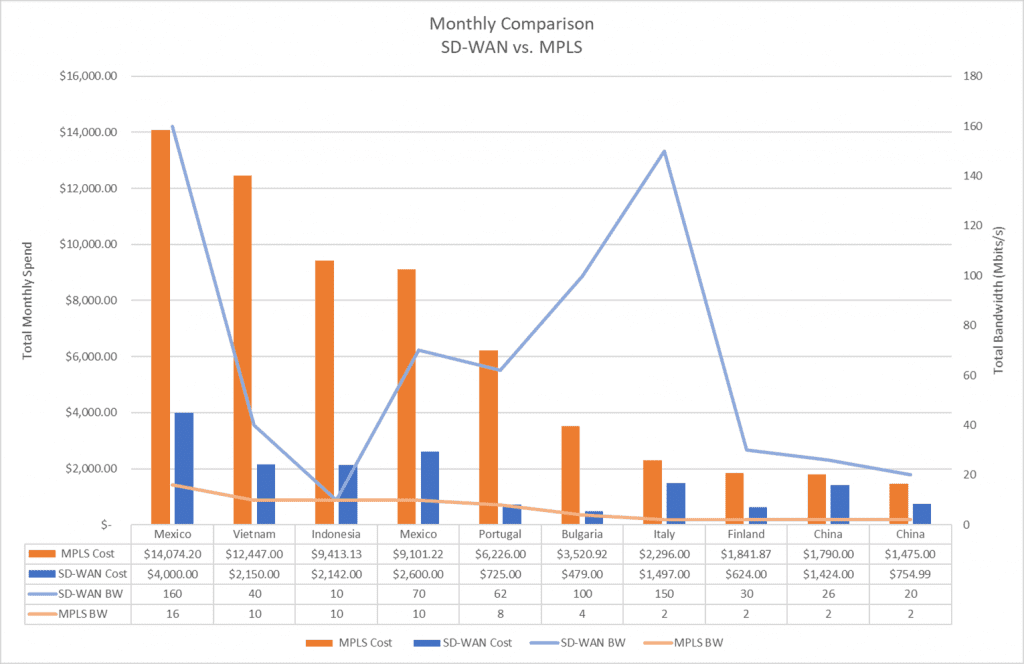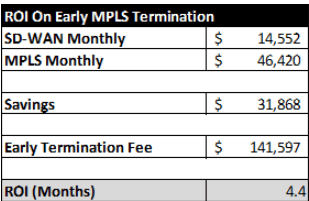The common wisdom has it that you wait till your MPLS contract finishes before switching to SD-WAN. But don’t assume common wisdom applies to your deployment. Sometimes, SD-WAN’s cost savings are so significant, terminating MPLS contracts early and incurring any penalities can still result in significant cost savings.
Case in point was one global customer of mine. The company, a global manufacturer, had an MPLS network connecting three data centers and two global headquarters split between Japan and the US, a dozen manufacturing plants across Japan, Thailand, and China, and another 15 sites as sales offices and warehouses across the US. Secured Internet access was provided through a data center in each region — one in Japan, one in California, and one in Frankfurt.
MPLS’s High Costs Hit More Than The Bottom Line
The company was desperately interested in leaving MPLS. It’s easy to see why. The company was paying as much as $1,244 per megabit at some sites when they reached out to us. We conducted a thorough analysis of the network, documenting for them their applications and application requirements, the site bandwidths, latency and loss metrics for the different routes, the total cost of operating three regional service stacks, and more.
You can see an excerpt from their report below showing the 10 locations with the highest cost per megabit. Vietnam topped the chart, China is at the bottom but even China is still ~700x more than the lowest costing circuits in the US.
While the impact on the budget might be the most obvious outgrowth of MPLS’ high costs, it’s not the only one. Spending more meant that the client had to restrict the amount of bandwidth at each site, which in turn impacted the application experience. In China, for example, users complained about sluggish SAP performance and an inability to use video conferencing because the link was only 2 Mbits/s.
MPLS costs meant that they had to be careful about which sites would get redundant connections. Manufacturing plants obviously needed redundancy. Factory lines at each plant operated 24 x 7. A few hours of network downtime at a plant would translate into lost revenue of $1 million, the VP of infrastructure told me. Other locations — data centers, warehouses, sales offices, and headquarters — that could benefit from redundant last-mile connections, though, couldn’t cost justify them.
But the company was locked into its MPLS contracts. Most circuits would only expire in another two years and breaking the contracts early meant paying their MPLS provider hundreds of thousands in penalties.
SD-WAN Destroys MPLS In A Cost Comparison
After conducting our analysis of the network, we showed the company the incredible value afforded by SD-WAN. There are many good reasons to adopt SD-WAN. You can deploy sites faster. Increase capacity when you need it. Take advantage of any type of last-mile connection. Improve cloud performance. I can go on.
But sometimes a compelling reason for switching to SD-WAN is simply the cost savings. Take a look at the same countries now with SD-WAN and direct Internet access (DIA) circuits in place. Notice the dramatic drop in costs per megabit drop In the case of Vietnam, for example, this is a 95% savings per megabit per month.
But not only is the company reducing spend, but it’s also increasing bandwidth. The Vietnam site saw bandwidth grow by 400 percent. In Italy, the company jumped bandwidth by 7,500 percent.
With so much more bandwidth available, you will probably want to give up on some of those savings for more value. In Vietnam, for example, total bandwidth spend didn’t drop by the bandwidth cost savings of 95 percent; it only dropped by 82 percent (yes, that’s a bit of sarcasm), decreasing from $12,447 per month to $2,150 per month. You can see the complete comparisons of the sites below.
And along with the savings and total bandwidth came improvements in redundancy. By using more affordable Internet lines, we were able to give all locations redundant connections. The costs and capacities you see are for both connections. The SD-WAN device manages the failover between the connections.
What’s more by deploying an SD-WAN with embedded security we were able to eliminate the secure Internet gateways in each region. The result: another $3 million saved over 36-months for the data center, connectivity, redundant security stack, and management. If your SD-WAN lacks a next-generation firewall (NGFW), you’ll want to factor those costs in as well — and the necessary security expertise to configure and deploy the firewall.

And What About Those Penalities?
The value of SD-WAN was so overwhelming we were able to show that it even outweighed the cost of breaking the MPLS contracts. Originally, the company was set to pay their MPLS provider fees in as much as $5 million for the early break. But the company also had some leverage since they used the provider for a variety of other services. After some discussions and negotiations, the penalties were reduced to six months of the monthly recurring cost (MRC) for each circuit terminated. The rest was simple math.
Specifics varied by location but here’s an example from our termination of nine sites in Mexico. Each month, the customer would be saving about $32,000 by going with SD-WAN instead of MPLS. Even with early termination fees coming to about $142,000, we could show a return in just over four months.
The Bottom Line of This Bottom Line Analysis
Early termination of MPLS is most definitely something that should be carefully considered. The value of SD-WAN is so great that all too often you’ll see a return in a matter of months AND dramatically improve your user experience. To see if early termination makes sense for your organization, contact us for a free assessment.


